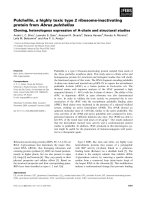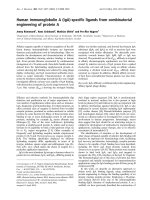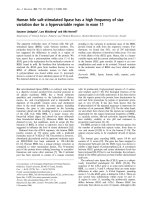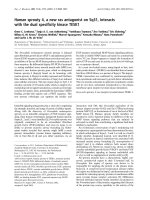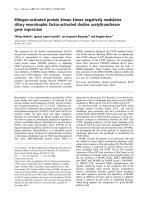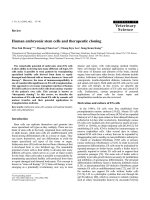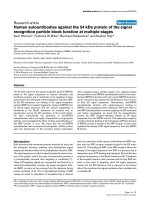Báo cáo y học: "Human T-cell leukemia virus type I infects human lung epithelial cells and induces gene expression of cytokines, chemokines and cell adhesion molecules" ppt
Bạn đang xem bản rút gọn của tài liệu. Xem và tải ngay bản đầy đủ của tài liệu tại đây (849.93 KB, 10 trang )
BioMed Central
Page 1 of 10
(page number not for citation purposes)
Retrovirology
Open Access
Research
Human T-cell leukemia virus type I infects human lung epithelial
cells and induces gene expression of cytokines, chemokines and cell
adhesion molecules
Hiromitsu Teruya
1,2
, Mariko Tomita
1
, Masachika Senba
3
, Chie Ishikawa
1,4,5
,
Maki Tamayose
2
, Akiko Miyazato
6
, Satomi Yara
2
, Yuetsu Tanaka
7
,
Yoichiro Iwakura
8
, Jiro Fujita
2
and Naoki Mori*
1
Address:
1
Division of Molecular Virology and Oncology, Graduate School of Medicine, University of the Ryukyus, 207 Uehara, Nishihara,
Okinawa, Japan,
2
Division of Control and Prevention of Infectious Diseases, Graduate School of Medicine, University of the Ryukyus, 207 Uehara,
Nishihara, Okinawa, Japan,
3
Department of Pathology, Institute of Tropical Medicine, Nagasaki University, 1-12-4 Sakamoto, Nagasaki, Japan,
4
Division of Child Health and Welfare, Faculty of Medicine, University of the Ryukyus, 207 Uehara, Nishihara, Okinawa, Japan,
5
The Japanese
Society for the Promotion of Science (JSPS), Japan,
6
Department of Infectious Diseases and Infection Control, International Medical Center,
Saitama Medical School, 1397-1 Yamane Hidaka, Saitama, Japan,
7
Division of Immunology, Faculty of Medicine, University of the Ryukyus, 207
Uehara, Nishihara, Okinawa, Japan and
8
Center for Experimental Medicine, The Institute of Medical Science, The University of Tokyo, 4-6-1
Shirokanedai, Minato-ku, Tokyo, Japan
Email: Hiromitsu Teruya - ; Mariko Tomita - ;
Masachika Senba - ; Chie Ishikawa - ; Maki Tamayose - ;
Akiko Miyazato - ; Satomi Yara - ; Yuetsu Tanaka - ;
Yoichiro Iwakura - ; Jiro Fujita - ; Naoki Mori* -
* Corresponding author
Abstract
Background: Human T-cell leukemia virus type I (HTLV-I) is associated with pulmonary diseases,
characterized by bronchoalveolar lymphocytosis, which correlates with HTLV-I proviral DNA in carriers.
HTLV-I Tax seems to be involved in the development of such pulmonary diseases through the local
production of inflammatory cytokines and chemokines in T cells. However, little is known about induction
of these genes by HTLV-I infection in lung epithelial cells.
Results: We tested infection of lung epithelial cells by HTLV-I by coculture studies in which A549 alveolar
and NCI-H292 tracheal epithelial cell lines were cocultured with MT-2, an HTLV-I-infected T-cell line.
Changes in the expression of several cellular genes were assessed by reverse transcription-polymerase
chain reaction, enzyme-linked immunosorbent assay and flow cytometry. Coculture with MT-2 cells
resulted in infection of lung epithelial cells as confirmed by detection of proviral DNA, HTLV-I Tax
expression and HTLV-I p19 in the latter cells. Infection was associated with induction of mRNA expression
of various cytokines, chemokines and cell adhesion molecule. NF-κB and AP-1 were also activated in
HTLV-I-infected lung epithelial cells. In vivo studies showed Tax protein in lung epithelial cells of mice
bearing Tax and patients with HTLV-I-related pulmonary diseases.
Conclusion: Our results suggest that HTLV-I infects lung epithelial cells, with subsequent production of
cytokines, chemokines and cell adhesion molecules through induction of NF-κB and AP-1. These changes
can contribute to the clinical features of HTLV-I-related pulmonary diseases.
Published: 22 September 2008
Retrovirology 2008, 5:86 doi:10.1186/1742-4690-5-86
Received: 14 August 2008
Accepted: 22 September 2008
This article is available from: />© 2008 Teruya et al; licensee BioMed Central Ltd.
This is an Open Access article distributed under the terms of the Creative Commons Attribution License ( />),
which permits unrestricted use, distribution, and reproduction in any medium, provided the original work is properly cited.
Retrovirology 2008, 5:86 />Page 2 of 10
(page number not for citation purposes)
Background
Human T-cell leukemia virus type I (HTLV-I) is a retrovi-
rus responsible for adult T-cell leukemia (ATL) [1] and a
chronic neurological disorder known as HTLV-I-associ-
ated myelopathy/tropical spastic paraparesis (HAM/TSP)
[2,3]. HTLV-I is also implicated in several other inflamma-
tory disorders, such as uveitis, chronic arthropathy and
Sjögren's syndrome [4]. Furthermore, transgenic mice
expressing Tax protein, a transactivator encoded by HTLV-
I, develop proliferative synovitis [5] and exocrinopathies
affecting lacrimal and salivary glands, features similar to
those of Sjögren's syndrome in humans [6]. Individuals
infected with HTLV-I are also known to show pulmonary
involvement. For example, patients with HAM/TSP and
uveitis or asymptomatic carriers frequently exhibit pul-
monary complications characterized by T-lymphocyte
alveolitis or lymphocytic interstitial pneumonia [7,8]. In
Tax-expressing transgenic mice, inflammatory cells con-
sisting mainly of lymphocytes accumulate in peribronchi-
olar and perivascular areas as well as in alveolar septa [9].
Immunological mechanisms are believed to play an
important role in the pathogenesis of T-lymphocyte alve-
olitis in patients infected with HTLV-I, based on the cyto-
toxic immune response of CD8+ T cells [10], and the
presence of circulating CD8+ cytotoxic T cells specific for
the HTLV-I Tax in patients with HAM/TSP [11,12]. T lym-
phocytes, especially CD4+ T cells, are the main target of
HTLV-I in vivo and carry the majority of the HTLV-I provi-
ral load [13,14]. In bronchoalveolar lavage fluid of HTLV-
I carriers, the copy number of HTLV-I proviral DNA corre-
lates with the number of lymphocytes [15]. On the other
hand, it has been estimated that there are 28000 type I
pneumocytes, 1400 type II pneumocytes and 50 alveolar
macrophages per alveolus in an average human male [16].
However, little is known about the tropism of HTLV-I for
lung epithelial cells. Because HTLV-I exhibits tropism for
synoviocytes, thyrocytes and retinal glial cells [17-19], we
sought to determine whether lung epithelial cells can be
infected with HTLV-I and whether such infection modu-
lates the expression of cellular genes.
Methods
Cell culture and in vitro HTLV-I infection
Human A549, a type II alveolar epithelial cell line, and
NCI-H292, a tracheal epithelial cell line, were maintained
in RPMI 1640 containing 10% fetal bovine serum (FBS).
MT-2 cells, obtained by coculture of peripheral leukemic
cells from an ATL patient with normal umbilical cord leu-
cocytes [20], were used as the HTLV-I-infected T-cell line.
MT-2 cells contained proviral HTLV-I DNA and produced
viral particles. CCRF-CEM cells were used as the unin-
fected T-cell line. These T cells were treated with 100 μg/
ml of mitomycin C (MMC) for 1 h at 37°C. After washing
three times with phosphate buffered saline (PBS), they
were cultured with an equal number of epithelial cells in
RPMI 1640 containing 10% FBS. The culture medium was
changed on the third day after coculture. A549 and NCI-
H292 cells were harvested at 3, 5, 8 and 14 days, followed
by DNA and RNA extraction, as described below. Samples
of the culture supernatant were collected at 3 and 5 days
after infection and used to measure the p19 antigen of
HTLV-I (ZeptoMetrix, Buffalo, NY), IL-8 (BioSource Inter-
national, Camarillo, CA) and CCL20 (R&D Systems, Min-
neapolis, MN) by enzyme-linked immunosorbent assay
(ELISA).
RT-PCR
Total RNA was extracted with Trizol (Invitrogen, Carlsbad,
CA) according to the protocol provided by the manufac-
turer. First-strand cDNA was synthesized from 5 μg total
cellular RNA using an RNA PCR kit (Takara Bio Inc., Otsu,
Japan) with random primers. Thereafter, cDNA was
amplified. The sequences of the primers were described
previously [18,21-30]. PCR products were fractionated on
2% agarose gels and visualized by ethidium bromide
staining.
Measurement of HTLV-I proviral load
DNA was prepared from each sample and stored at -80°C
until use. The concentration of extracted DNA was
adjusted to 10 ng/μl of the working solution. A quantita-
tive real-time PCR assay was developed to measure the
proviral load of HTLV-I in cells, as described previously
[18].
Immunohistochemical staining
We examined lung biopsy specimens from three patients
with HTLV-I-related pulmonary diseases or normal lung
biopsies, and lung biopsy specimens from transgenic mice
bearing Tax or control littermate mice [9]. All subjects pro-
vided informed consent before samples were obtained.
The tissue samples were subjected to immunohistochem-
ical staining using the mouse monoclonal antibody (Ab)
to Tax, Lt-4 [31]. Serial sections were deparaffinized. Anti-
genic sites bound by the Ab were identified by reacting the
sections with a mixture of 0.05% 3,3'-diaminobenzidine
tetrahydrochloride in 50 mM Tris-HCl buffer and 0.01%
hydrogen peroxide. Sections were counterstained with
methyl green.
Western blot analysis
Cells were lysed in a buffer containing 62.5 mM Tris-HCl
(pH 6.8), 2% sodium dodecyl sulfate, 10% glycerol, 6% 2-
mercaptoethanol and 0.01% bromophenol blue. Equal
amounts of protein (20 μg) were subjected to electro-
phoresis on sodium dodecyl sulfate-polyacrylamide gels,
followed by transfer to a polyvinylidene difluoride mem-
brane and sequential probing with the specific antibodies.
The bands were visualized with an enhanced chemilumi-
Retrovirology 2008, 5:86 />Page 3 of 10
(page number not for citation purposes)
nescence kit (Amersham Biosciences, Piscataway, NJ).
Mouse monoclonal Ab to actin was purchased from Neo-
Markers (Fremont, CA). Mouse monoclonal Ab to Tax, Lt-
4, was used.
Flow cytometry
To measure the expression of ICAM-1 and LFA-1 on the
surface of epithelial cells after HTLV-I infection, FITC-
labeled mouse monoclonal Ab against ICAM-1, LFA-1 α
chain or control mouse IgG1 (Coulter Immunotech Co.,
Marseille, France) was used. Cells were analyzed on an
Epics XL flow cytometer (Beckman Coulter, Fullerton,
CA) after gating on forward and side scatter to exclude
debris and clumps.
Reporter assay
A549 cells were transfected with a luciferase reporter con-
struct for the HTLV-I long terminal repeat (LTR), and NF-
κB and AP-1 reporter constructs [22,28,30] using Lipo-
fectamine (Invitrogen). After 24 h, the transfected A549
cells were cocultured in the presence or absence of MMC-
treated MT-2 or CCRF-CEM cells for 24 h before luciferase
assay. Luciferase activities were measured using the dual
luciferase assay system (Promega, Madison, WI) and nor-
malized by the Renilla luciferase activity from phRL-TK.
Electrophoretic mobility shift assay (EMSA)
EMSA was performed as described previously [22,30].
Briefly, 5 μg of nuclear extract was incubated with
32
P-
labeled probes. The DNA-protein complex was separated
from the free oligonucleotides on a 4% polyacrylamide
gel. For competition experiments, the cold oligonucle-
otide probe or competitors were used, and supershift
analysis was performed using Abs against NF-κB subunits
p50, p65, c-Rel, p52 and RelB, and AP-1 subunits c-Fos,
FosB, Fra-1, Fra-2, c-Jun, JunB and JunD (Santa Cruz Bio-
technology, Santa Cruz, CA).
Results
Detection of HTLV-I antigens and proviral DNA in lung
epithelial cells cocultured with HTLV-I infected T cells
A549 and NCI-H292 cells were cocultured with either MT-
2 or CCRF-CEM cells. After cocultivation for 3 days, A549
and NCI-H292 cells were washed extensively and recul-
tured in a fresh medium for another 2 days, followed by
thorough washing. At 3 and 5 days post-cocultivation,
A549 and NCI-H292 cells were harvested for assessment
by RT-PCR for expression of HTLV-I viral antigen. Since T-
cell lines were pretreated extensively with MMC, these
MMC-treated T cells could not proliferate, as determined
by cell proliferation assay. These specimens of A549 and
NCI-H292 cells at 3 and 5 days of culture contained no
viable MT-2 cells. As shown in Figure 1, A549 and NCI-
H292 cells cocultured with MT-2 cells showed strong
expression of Tax mRNA. In contrast, A549 and NCI-
H292 cells cocultured with CCRF-CEM cells did not
express Tax mRNA. Using RNA samples prepared from
A549 cells cocultured with non-permissible HTLV-I-
infected T cell line, TL-OmI [32], RT-PCR was carried out,
but Tax mRNA was not detected (data not shown).
We next performed Western blot analysis to assess the
expression of Tax protein in A549 cells cocultured with
MT-2 or CCRF-CEM cells. As shown in Figure 2B, A549
cells cocultured with MT-2 cells for 3 days expressed Tax
protein. In contrast, A549 cells cocultured with CCRF-
Detection of HTLV-I Tax mRNA in A549 and NCI-H292 cells by RT-PCRFigure 1
Detection of HTLV-I Tax mRNA in A549 and NCI-H292 cells by RT-PCR. Both cell lines were cocultured with
MMC-treated MT-2 or CCRF-CEM cells. At 3 and 5 days after cocultivation, A549 and NCI-H292 cells were harvested and
then Tax mRNA expression was analyzed. Human β-actin mRNA was used as a control.
Retrovirology 2008, 5:86 />Page 4 of 10
(page number not for citation purposes)
CEM cells did not express Tax protein. These results sug-
gest that HTLV-I can be transmitted into lung epithelial
cells from HTLV-I producing MT-2 cells.
To confirm the production of viral protein, A549 and
NCI-H292 cells were first cocultured for 3 days either
alone (control) or with MMC-treated MT-2 cells, then
washed extensively and recultured in a fresh medium for
2 days. At the end of this period, the level of HTLV-I p19
core protein was measured in culture supernatants. Pro-
duction of HTLV-I p19 was evident after 3 day of infec-
tion; the levels of HTLV-I p19 in the supernatants of A549
and NCI-H292 cells infected with HTLV-I were 1337 and
1023 pg/ml, respectively. The level of p19 in the superna-
tant of the MMC-treated MT-2 cells, the number of which
corresponds to that used for coculturing, was less than 25
pg/ml. These results argue against the possibility that the
p19 in the supernatant was produced by residual MT-2
cells used for infection, and support our conclusion that
lung epithelial cells are infected by HTLV-I.
Using DNA samples extracted from cocultured lung epi-
thelial cells, the pX region sequence of HTLV-I proviral
DNA was amplified by real-time PCR. In A549 cells, the
proviral copy numbers per 100 cells were 100, 100 and 64
at 3, 5 and 14 days, respectively. In NCI-H292 cells, the
proviral copy numbers were 100, 84 and 40 at 3, 5 and 8
days, respectively. Taken together, our observations sug-
gest that coculturing of lung epithelial cells with MT-2
resulted in infection with HTLV-I.
Induction of expression of cytokines, chemokines and cell adhesion molecule in A549 cells cocultured with MT-2 cellsFigure 2
Induction of expression of cytokines, chemokines and cell adhesion molecule in A549 cells cocultured with MT-
2 cells. A549 cells were cocultured with MMC-treated MT-2 or CCRF-CEM cells. At 3 and 5 days after cocultivation, A549
cells were harvested and then the expression of the indicated genes was analyzed by RT-PCR. (A) Genes that were upregu-
lated by HTLV-I infection. (B) Detection of Tax protein in A549 cells cocultured with MT-2 cells. (C) Genes that were not
affected by HTLV-I infection. (D) Expression of cytokine genes in NCI-H292 cells cocultured with MT-2 or CCRF-CEM cells.
Retrovirology 2008, 5:86 />Page 5 of 10
(page number not for citation purposes)
Expression levels of several genes in HTLV-I-infected lung
epithelial cells
Tax activates not only the transcription of the viral
genome but also the expression of various cellular genes
[33]. Therefore, we investigated the expression of inflam-
matory cytokines, chemokines and cell adhesion mole-
cules in A549 cells cocultured with MT-2 or CCRF-CEM
cells by RT-PCR. As shown in Figure 2A, the expression
levels of IL-1α, IL-1β, IL-6, IL-8, TNF-α, CCL2 (MCP-1),
CCL5 (RANTES), and ICAM-1 were increased in A549
cells cocultured with MT-2 cells, but not in A549 cells coc-
ultured with CCRF-CEM cells at 3 and 5 days. The expres-
sion levels of most genes were decreased at 5 days after
infection. The expression levels of TGF-β1 and CCL20
(MIP-3α) were increased in A549 cells cocultured with
MT-2 cells at 5 and 3 days, respectively. Transcripts of IFN-
γ and IL-10 were not detected in any of the samples. Tran-
scripts of inducible nitric oxide synthase (iNOS) and IL-
12 p40 were detected in control A549 cells, and expres-
sion levels were not different between samples (Figure
2C). Cytokine gene expression in NCI-H292 cells was also
studied by RT-PCR, using cDNA samples prepared from
cocultured cells. As shown in Figure 2D, high expression
levels of IL-1α, IL-1β and TGF-β1 mRNA were detected in
control NCI-H292 cells. However, the expression level of
TNF-α was increased in NCI-H292 cells cocultured with
MT-2 cells at 3 and 5 days.
The expression level of Tax mRNA was equivalent in A549
cells cocultured with MT-2 cells at 3 and 5 days, but the
expression level of Tax protein was suppressed at 5 days
(Figure 2B). Therefore, the expression of several cellular
genes correlated with that of Tax. MT-2 cells expressed
IFN-γ and IL-10 mRNA, but not IL-1β and IL-8 mRNA.
However, A549 cells cocultured with MT-2 cells expressed
IL-1β and IL-8 mRNA, but not IFN-γ and IL-10 mRNA,
which suggests that residual MT-2 cells in these samples
were not amplified.
We also investigated the production of IL-8 and CCL20 by
A549 cells cocultured with MT-2 or CCRF-CEM cells.
A549 cells cocultured with MMC-treated MT-2 cells
released considerable amounts of IL-8 and CCL20 (Figure
3A). IL-8 was not detected in the media of MMC-treated
MT-2 cells. We also measured the surface expression of
ICAM-1 and LFA-1 on cocultured A549 cells by flow
cytometry. Figure 3B shows that the fraction of cells
expressing ICAM-1 but not LFA-1 was higher in A549 cells
cocultured with MT-2 cells. Thus, consistent with the abil-
ity of HTLV-I to induce transcription of several cellular
genes, infection of lung epithelial cells with HTLV-I
increased the production of cytokines and chemokines
and induced the surface expression of cell adhesion mol-
ecule.
Activation of NF-
κ
B and AP-1, and viral promoter LTR in
HTLV-I-infected lung epithelial cells
Tax activates the expression of various cellular genes
through the NF-κB and AP-1 pathways [33]. Therefore, we
investigated the transcriptional activity of NF-κB and AP-
1. A549 cells cocultured with MT-2 cells exhibited high
transcriptional activity of NF-κB and AP-1, compared with
control A549 cells and A549 cells cocultured with CCRF-
CEM cells (Figure 4A). Furthermore, viral promoter LTR
was activated in A549 cells cocultured with MT-2 cells,
suggesting that A549 cells were infected with HTLV-I.
Next, we examined DNA-binding of NF-κB and AP-1.
A549 cells were cocultured with MMC-treated MT-2 or
CCRF-CEM cells, and the DNA-binding activity of NF-κB
and AP-1 was assessed by EMSA. As evidenced from Figure
4B, coculture of A549 cells with MT-2 induced the DNA-
binding of NF-κB and AP-1. These complexes were due to
specific binding of nuclear proteins to each sequence
because the binding activities were reduced by the addi-
tion of cold probe but not by an irrespective sequence.
This gel shift assay detected an NF-κB complex that was
supershifted by anti-p50, anti-p65 and anti-c-Rel Abs, and
an AP-1 complex that was supershifted by anti-JunD Ab as
was noted in HTLV-I-infected T-cell lines [34,35] (Figure
4C).
Detection of Tax protein in the lungs of Tax transgenic
mice and patients with HTLV-I-related pulmonary diseases
Finally, we immunostained lung tissues of transgenic
mice to assess the expression of viral antigen Tax. Lym-
phocytes accumulated in alveolar septa of the lungs of
transgenic mice (Figure 5A; right lower panel), but not in
littermate mice (data not shown). We examined the distri-
bution of Tax protein in the lungs of transgenic mice.
Marked expression of Tax was observed in epithelial cells
(Figure 5A) as well as lymphocytes (Figure 5B) and mac-
rophages (Figure 5C) in the lungs of transgenic mice. We
next immunostained lung tissues obtained from patients
with HTLV-I-related pulmonary diseases. Compatible
with the lungs of HTLV-I-related pulmonary diseases,
accumulation of lymphocytes was noted in alveolar septa
(Figure 5D; right lower panel). Tax expression was noted
in epithelial cells (Figure 5D), lymphocytes (Figure 5E)
and macrophages (Figure 5F) of patients with HTLV-I-
related pulmonary diseases, but not those of normal lungs
(data not shown).
Discussion
We obtained evidence that lung epithelial cells can be
infected by HTLV-I and that this infection induced several
genes expression. By coculturing A549 and NCI-H292
cells with the MT-2 cell line, HTLV-I proviral DNA was
detected from 3 days to 2 weeks. Demonstration of
expression of viral Tax at both mRNA and protein levels,
and production of a viral antigen p19 in the supernatant
Retrovirology 2008, 5:86 />Page 6 of 10
(page number not for citation purposes)
Secretion of IL-8 and CCL20 and Induction of cell surface ICAM-1 expression in A549 cells cocultured with MT-2 cellsFigure 3
Secretion of IL-8 and CCL20 and Induction of cell surface ICAM-1 expression in A549 cells cocultured with
MT-2 cells. (A) Secretion of IL-8 and CCL20 by A549 cells cocultured with MT-2 or CCRF-CEM cells. At 5 days after coculti-
vation, the levels of IL-8 and CCL20 in the supernatants were measured. Data are mean ± SD. (B) Induction of cell surface
ICAM-1 expression on A549 cells cocultured with MT-2 or CCRF-CEM cells. At 5 days after cocultivation, the cell surface
expression of ICAM-1 and LFA-1 was examined by flow cytometry. A549 cells were stained with FITC-labeled anti-ICAM-1,
anti-LFA-1 α chain or the isotype control Ab.
Retrovirology 2008, 5:86 />Page 7 of 10
(page number not for citation purposes)
also provided supportive evidence that HTLV-I infection
and viral gene expression had taken place in lung epithe-
lial cells. The proviral copy numbers showed a gradual
decrease after infection. This transient infection was noted
in retinal glial cells [19]. The possibility that HTLV-I-
infected lung epithelial cells do not produce a large
amount of virus and show a slower growth rate was raised
by a report of Sato et al [19]. Recent data have indicated
that HTLV-I infection leads to arrest in G
1
phase of the cell
cycle and senescence [36,37]. Another possibility is that
HTLV-I infection might have induced apoptosis of
infected cells, hence, elimination of the infected cells [19].
In this study, HTLV-I Tax was detected in lung epithelial
cells from patients with HTLV-I-related pulmonary dis-
eases and Tax transgenic mice. This finding indicates that
Activation of transcription factors NF-κB and AP-1, and viral promoter LTR in A549 cells cocultured with MT-2 cellsFigure 4
Activation of transcription factors NF-κB and AP-1, and viral promoter LTR in A549 cells cocultured with MT-
2 cells. (A) A549 cells were transfected with κB-LUC, AP-1-LUC or LTR-LUC. After 24 h, transfected A549 cells were cocul-
tured with MMC-treated MT-2 or CCRF-CEM cells for 24 h before luciferase assay. Luciferase activity is presented as a fold
induction relative to the basal level measured in A549 cells that were not cocultured with MT-2 or CCRF-CEM cells. Relative
luciferase amounts were normalized to equivalent Renilla expression to control for transfection efficiency. Data are mean ± SD
values of three independent experiments. (B) DNA-binding activities of NF-κB and AP-1 in A549 cells. A549 cells were cocul-
tured with MMC-treated MT-2 or CCRF-CEM cells. At 3 and 5 days after cocultivation, A549 cells were harvested and then
NF-κB and AP-1 DNA-binding activities were analyzed by EMSA. Specific bands are indicated by arrows. (C) Characterization
of DNA-protein complexes present in nuclei of A549 cells cocultured with MT-2 cells. At 5 days after cocultivation, nuclear
extracts were prepared from A549 cells. The competitors used were the NF-κB site of the IL-2 receptor α chain gene and the
AP-1 site of the IL-8 gene. Supershift assay in the same nuclear extracts was also performed. Supershifted bands with Abs are
indicated by arrowheads.
Retrovirology 2008, 5:86 />Page 8 of 10
(page number not for citation purposes)
HTLV-I can be transmitted into lung epithelial cells from
infected T cells and the integrated HTLV-I genes can be
transcribed and expressed.
Lung epithelial cells produce a variety of cytokines and
chemokines that regulate the immune system. They also
function as an important sentinel system against patho-
gens. The pathogenic significance of aberrant production
of inflammatory cytokines and chemokines in the lung
has been given increasing attention and a variety of
cytokines and chemokines are considered to play impor-
tant roles in the pathogenesis of lung inflammatory dis-
eases. Lung epithelial cells cocultured with MT-2 cells
expressed the mRNAs of IL-1α, IL-1β, IL-6, IL-8, TNF-α,
TGF-β1, CCL2, CCL5, CCL20 and ICAM-1, but not IFN-γ,
IL-10, iNOS and IL-12 p40. The expression of IL-1α, IL-1β,
IL-6, IL-8, TNF-α, CCL2, CCL5 and CCL20 is regulated by
NF-κB [22,24,30,38]. Furthermore, IL-8 and TGF-β1 are
AP-1 targets [30,39]. In contrast, the expression of IL-10 is
mediated by STAT [40]. There are many putative transcrip-
tion factor-binding sites such as AP-1, GATA, NF-AT and
ATF in the promoter of IFN-γ gene and they play a key role
in the transcription of IFN-γ gene [41]. NF-κB, STAT, AP-
1, C/EBPβ and β-catenin/TCF4 are important transcrip-
tion factors in regulation of iNOS expression [42]. Fur-
thermore, NF-κB, Ets, C/EBPβ, Sp1 and AP-1 contribute to
the regulation of IL-12 p40 expression [43]. Because the
expression of genes that were induced in A549 cells cocul-
tured with MT-2 cells was regulated by only NF-κB and
AP-1, and Tax protein increases transcription of cellular
genes through NF-κB and AP-1, [33] we examined the
activities of NF-κB and AP-1 in these cells. As expected,
these cells exhibited aberrant activation of NF-κB and AP-
1. These findings suggest that Tax protein could induce the
transcription of cytokines, chemokines and cell adhesion
molecules in lung epithelial cells in a manner similar to
that in HTLV-I-infected T cells. The results of the present
study suggest that lung production of inflammatory
cytokines and chemokines by HTLV-I-infected epithelial
cells, in addition to that by infiltrating lymphocytes, may
also play a role in the pathogenesis of HTLV-I-related pul-
monary diseases. To confirm this hypothesis, further stud-
ies are necessary to carry out a histopathological and
molecular analysis study using lung specimens of Tax
transgenic mice and patients with HTLV-I-related pulmo-
nary diseases.
Detection of Tax protein by immunohistochemistryFigure 5
Detection of Tax protein by immunohistochemistry. In lung tissues of Tax transgenic mice (A-C) and patients with
HTLV-I-related pulmonary diseases (D-F), immunohistochemical staining showed definite brownish staining for Tax protein in
the cytoplasm of epithelial cells (A and D), and infiltrated lymphocytes (B and E) and macrophages (C and F).
Retrovirology 2008, 5:86 />Page 9 of 10
(page number not for citation purposes)
Conclusion
It has been reported that immunoregulatory disturbances
caused by HTLV-I infection can cause inflammatory mul-
tisystem diseases, including uveitis, chronic arthropathy
and Sjögren's syndrome [4], in addition to the HAM/TSP
[2,3] and T-lymphocyte alveolitis or lymphocytic intersti-
tial pneumonia [7,8]. The pathological association of
HTLV-I with inflammatory multiorgan diseases in HTLV-I
carriers still remains to be clarified. Our study, however,
suggests that the variety of clinical syndromes may be
attributed to the cell tropism of HTLV-I and distribution
of HTLV-I-affected cells in various organs. In summary,
lung epitheial cells may be infected by HTLV-I. This proc-
ess promotes the production of inflammatory cytokines
and chemokines, and the expression of cell adhesion mol-
ecules by the infected cells. Such process may be involved
in the pathogenesis of HTLV-I-related pulmonary dis-
eases.
Competing interests
The authors declare that they have no competing interests.
Authors' contributions
HT designed the study, and performed the analysis. MS
performed immunohistochemical staining. MTo and CI
collected and assembled the data. MTa, SY, AM and JF pro-
vided lung biopsy specimens. YT and YI provided the anti-
body and the Tax-expressing transgenic mice, respectively.
NM made substantial contributions to the conception and
design of the study, wrote and drafted the manuscript, and
contributed to data interpretation. All authors read and
approved the final manuscript.
Acknowledgements
We thank Dr J. Fujisawa for providing κB-LUC; Dr N. Mukaida for provid-
ing AP-1 LUC; and Dr I. Futsuki for providing LTR-LUC. This work was sup-
ported by Grants-in-Aid for Scientific Research (C) from Japan Society for
the Promotion of Science; Scientific Research on Priority Areas from the
Ministry of Education, Culture, Sports, Science and Technology; and the
Takeda Science Foundation.
References
1. Hinuma Y, Nagata K, Hanaoka M, Nakai M, Matsumoto T, Kinoshita
KI, Shirakawa S, Miyoshi I: Adult T-cell leukemia: antigen in an
ATL cell line and detection of antibodies to the antigen in
human sera. Proc Natl Acad Sci USA 1981, 78:6476-6480.
2. Osame M, Usuku K, Izumo S, Ijichi N, Amitani H, Igata A, Matsumoto
M, Tara M: HTLV-I associated myelopathy, a new clinical
entity. Lancet 1986, 1:1031-1032.
3. Gessain A, Barin F, Vernant JC, Gout O, Maurs L, Calender A, de Thé
G: Antibodies to human T-lymphotropic virus type-I in
patients with tropical spastic paraparesis. Lancet 1985,
2:407-410.
4. Watanabe T: HTLV-1-associated diseases. Int J Hematol 1997,
66:257-278.
5. Iwakura Y, Tosu M, Yoshida E, Takiguchi M, Sato K, Kitajima I, Nish-
ioka K, Yamamoto K, Takeda T, Hatanaka M, Yamamoto H, Sekiguchi
T: Induction of inflammatory arthropathy resembling rheu-
matoid arthritis in mice transgenic for HTLV-I. Science 1991,
253:1026-1028.
6. Green JE, Hinrichs SH, Vogel J, Jay G: Exocrinopathy resembling
Sjögren's syndrome in HTLV-1 tax transgenic mice. Nature
1989, 341:72-74.
7. Sugimoto M, Nakashima H, Watanabe S, Uyama E, Tanaka F, Ando M,
Araki S, Kawasaki S: T-lymphocyte alveolitis in HTLV-I-associ-
ated myelopathy. Lancet 1987, 2:1220.
8. Sugimoto M, Mita S, Tokunaga M, Yamaguchi K, Cho I, Matsumoto M,
Mochizuki M, Araki S, Takatsuki K, Ando M: Pulmonary involve-
ment in human T-cell lymphotropic virus type-I uveitis: T-
lymphocytosis and high proviral DNA load in bronchoalveo-
lar lavage fluid. Eur Respir J 1993, 6:938-943.
9. Miyazato A, Kawakami K, Iwakura Y, Saito A: Chemokine synthesis
and cellular inflammatory changes in lungs of mice bearing
p40
tax
of human T-lymphotropic virus type 1. Clin Exp Immunol
2000, 120:113-124.
10. Couderc LJ, Caubarrere I, Venet A, Magdeleine J, Jouanelle A, Danon
F, Buisson G, Vernant JC: Bronchoalveolar lymphocytosis in
patients with tropical spastic paraparesis associated with
human T-cell lymphotropic virus type 1 (HTLV-1). Clinical,
immunologic, and cytologic studies. Ann Intern Med 1988,
109:625-628.
11. Jacobson S, Shida H, McFarlin DE, Fauci AS, Koenig S: Circulating
CD8
+
cytotoxic T lymphocytes specific for HTLV-I pX in
patients with HTLV-I associated neurological disease. Nature
1990, 348:245-248.
12. Asquith B, Mosley AJ, Heaps A, Tanaka Y, Taylor GP, McLean AR,
Bangham CRM: Quantification of the virus-host interaction in
human T lymphotropic virus I infection. Retrovirology 2005,
2:75.
13. Bangham CR: The immune control and cell-to-cell spread of
human T-lymphotropic virus type 1. J Gen Virol 2003,
84:3177-3189.
14. Kinet S, Swainson L, Lavanya M, Mongellaz C, Montel-Hagen A,
Craveiro M, Manel N, Battini J-L, Sitbon M, Taylor N: Isolated
receptor binding domains of HTLV-1 and HTLV-2 envelopes
bind Glut-1 on activated CD4+ and CD8+ T cells. Retrovirology
2007, 4:31.
15. Mori S, Mizoguchi A, Kawabata M, Fukunaga H, Usuku K, Maruyama
I, Osame M: Bronchoalveolar lymphocytosis correlates with
human T lymphotropic virus type I (HTLV-I) proviral DNA
load in HTLV-I carriers. Thorax 2005, 60:138-143.
16. Crandall ED, Kim KJ: Alveolar epithelial barrier properties. In
The Lung: Scientific Foundation Edited by: Crystal RJ, West JB. New
York: Raven Press; 1991:273-287.
17. Sakai M, Eguchi K, Terada K, Nakashima M, Yamashita I, Ida H,
Kawabe Y, Aoyagi T, Takino H, Nakamura T: Infection of human
synovial cells by human T cell lymphotropic virus type I. J Clin
Invest 1993, 92:1957-1966.
18. Matsuda T, Tomita M, Uchihara J-N, Okudaira T, Ohshiro K, Tomoy-
ose T, Ikema T, Masuda M, Saito M, Osame M, Takasu N, Ohta T,
Mori N: Human T cell leukemia virus type I-infected patients
with Hashimoto's thyroiditis and Graves's disease. J Clin Endo-
crinol Metab 2005, 90:5704-5710.
19. Sato Y, Ito K, Moritoyo T, Fujino Y, Masuda K, Yamaguchi K, Mochi-
zuki M, Izumo S, Osame M, Watanabe T: Human T-cell lympho-
tropic virus type 1 can infect primary rat retinal glial cells
and induce gene expression of inflammatory cytokines. Curr
Eye Res 1997, 16:782-791.
20. Miyoshi I, Kubonishi I, Yoshimoto S, Akagi T, Ohtsuki Y, Shiraishi Y,
Nagata K, Hinuma Y: Type C virus particles in a cord T-cell line
derived by co-cultivating normal human cord leukocytes and
human leukaemic T cells.
Nature 1981, 294:770-771.
21. Brenner CA, Tam AW, Nelson PA, Engleman EG, Suzuki N, Fry KE,
Larrick JW: Message amplification phenotyping (MAPPing): a
technique to simultaneously measure multiple mRNAs from
small numbers of cells. Biotechniques 1989, 7:1096-1103.
22. Mori N, Ueda A, Ikeda S, Yamasaki Y, Yamada Y, Tomonaga M, Mori-
kawa S, Geleziunas R, Yoshimura T, Yamamoto N: Human T-cell
leukemia virus type I Tax activates transcription of the
human monocyte chemoattractant protein-1 gene through
two nuclear factor-κB sites. Cancer Res 2000, 60:4939-4945.
23. Baba M, Imai T, Yoshida T, Yoshie O: Constitutive expression of
various chemokine genes in human T-cell lines infected with
human T-cell leukemia virus type 1: role of the viral transac-
tivator Tax. Int J Cancer 1996, 66:124-129.
Publish with BioMed Central and every
scientist can read your work free of charge
"BioMed Central will be the most significant development for
disseminating the results of biomedical researc h in our lifetime."
Sir Paul Nurse, Cancer Research UK
Your research papers will be:
available free of charge to the entire biomedical community
peer reviewed and published immediately upon acceptance
cited in PubMed and archived on PubMed Central
yours — you keep the copyright
Submit your manuscript here:
/>BioMedcentral
Retrovirology 2008, 5:86 />Page 10 of 10
(page number not for citation purposes)
24. Imaizumi Y, Sugita S, Yamamoto K, Imanishi D, Kohno T, Tomonaga
M, Matsuyama T: Human T cell leukemia virus type-I Tax acti-
vates human macrophage inflammatory protein-3α/CCL20
gene transcription via the NF-κB pathway. Int Immunol 2002,
14:147-155.
25. Ansai T, Yamamoto E, Awano S, Yu W, Turner AJ, Takehara T:
Effects of periodontopathic bacteria on the expression of
endothelin-1 in gingival epithelial cells in adult periodontitis.
Clin Sci 2002, 103:327S-331S.
26. Satoh M, Toma H, Sato Y, Takara M, Shiroma Y, Kiyuna S, Hirayama
K: Reduced efficacy of treatment of strongyloidiasis in
HTLV-I carriers related to enhanced expression of IFN-γ and
TGF-β1. Clin Exp Immunol 2002, 127:354-359.
27. Vieira P, de Waal-Malefyt R, Dang MN, Johnson KE, Kastelein R,
Fiorentino DF, deVries JE, Roncarolo MG, Mosmann TR, Moore KW:
Isolation and expression of human cytokine synthesis inhibi-
tory factor cDNA clones: homology to Epstein-Barr virus
open reading frame BCRFI. Proc Natl Acad Sci USA 1991,
88:1172-1176.
28. Mori N, Nunokawa Y, Yamada Y, Ikeda S, Tomonaga M, Yamamoto
N: Expression of human inducible nitric oxide synthase gene
in T-cell lines infected with human T-cell leukemia virus
type-I and primary adult T-cell leukemia cells. Blood 1999,
94:2862-2870.
29. de Waal Malefyt R, Figdor CG, Huijbens R, Mohan-Peterson S, Ben-
nett B, Culpepper J, Dang W, Zurawski G, de Vries JE: Effects of IL-
13 on phenotype, cytokine production, and cytotoxic func-
tion of human monocytes. Comparison with IL-4 and modu-
lation by IFN-γ or IL-10. J Immunol 1993, 151:6370-6381.
30. Mori N, Mukaida N, Ballard DW, Matsushima K, Yamamoto M:
Human T-cell leukemia virus type I Tax transactivates
human interleukin 8 gene through acting concurrently on AP-
1 and nuclear factor-κB-like sites. Cancer Res 1998,
58:3993-4000.
31. Tanaka Y, Yoshida A, Takayama Y, Tsujimoto H, Tsujimoto A, Hayami
M, Tozawa H:
Heterogeneity of antigen molecules recognized
by anti-tax1 monoclonal antibody Lt-4 in cell lines bearing
human T cell leukemia virus type I and related retroviruses.
Jpn J Cancer Res 1990, 81:225-231.
32. Sugamura K, Fujii M, Kannagi M, Sakitani M, Takeuchi M, Hinuma Y:
Cell surface phenotypes and expression of viral antigens of
various human cell lines carrying human T-cell leukemia
virus. Int J Cancer 1984, 34:221-228.
33. Hall W, Fujii M: Deregulation of cell-signaling pathways in
HTLV-1 infection. Oncogene 2005, 24:5965-5975.
34. Mori N, Fujii M, Ikeda S, Yamada Y, Tomonaga M, Ballard DW,
Yamamoto N: Constitutive activation of NF-κB in primary
adult T-cell leukemia cells. Blood 1999, 93:2360-2368.
35. Mori N, Fujii M, Iwai K, Ikeda S, Yamasaki Y, Hata T, Yamada Y, Tan-
aka Y, Tomonaga M, Yamamoto N: Constitutive activation of
transcription factor AP-1 in primary adult T-cell leukemia
cells. Blood 2000, 95:3915-3921.
36. Liu M, Yang L, Zhang L, Liu B, Merling R, Xia Z, Giam C-Z: HTLV-1
infection leads to arrest in the G1 phase of the cell cycle. J
Virol 2008, 82:8442-8455.
37. Merling R, Chen C, Hong S, Zhang L, Liu M, Kuo Y-L, Giam C-Z:
HTLV-1 Tax mutants that do not induce G
1
arrest are disa-
bled in activating the anaphase promoting complex. Retrovi-
rology 2007, 4:35.
38. Pahl HL: Activators and target genes of Rel/NF-κB transcrip-
tion factors. Oncogene 1999, 18:6853-6866.
39. Kim S-J, Kehrl JH, Burton J, Tendler CL, Jeang K-T, Danielpour D,
Thevenin C, Kim KY, Sporn MB, Roberts AB: Transactivation of
the transforming growth factor β1 (TGF-β1) gene by human
T lymphotropic virus type 1 tax: a potential mechanism for
the increased production of TGF-β1 in adult T cell leukemia.
J Exp Med 1990, 172:121-129.
40. Unterberger C, Staples KJ, Smallie T, Williams L, Foxwell B, Schaefer
A, Kempkes B, Hofer TPJ, Koeppel M, Lohrum M, Stunnenberg H,
Frankenberger M, Ziegler-Heitbrock L: Role of STAT3 in gluco-
corticoid-induced expression of the human IL-10 gene. Mol
Immunol 2008, 45:3230-3237.
41. Barbulescu K, Meyer zum Büschenfelde KH, Neurath MF: Constitu-
tive and inducible protein/DNA interactions of the inter-
feron-γ promoter in vivo in CD45RA and CD45R0 T helper
subsets. Eur J Immunol 1997, 27:1098-1107.
42. Guo Z, Shao L, Du Q, Park KS, Geller DA: Identification of a clas-
sic cytokine-induced enhancer upstream in the human iNOS
promoter. FASEB J 2007, 21:535-542.
43. Sun H-J, Xu X, Wang X-L, Wei L, Li F, Lu J, Huang B-Q: Transcrip-
tion factors Ets2 and Sp1 act synergistically with histone
acetyltransferase p300 in activating human interleukin-12
p40 promoter. Acta Biochim Biophys Sin 2006, 38:194-200.

